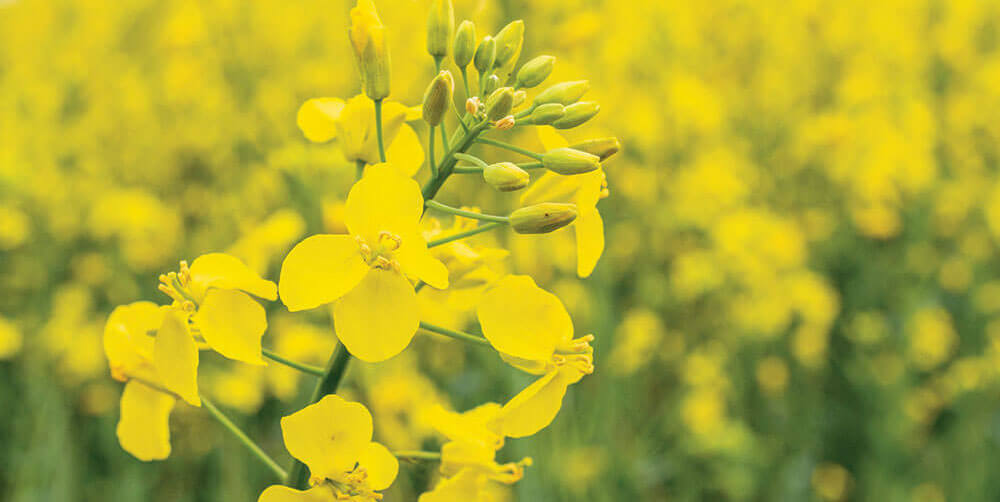Canola AgriScience Cluster – turning research into knowledge
THE CANOLA AGRISCIENCE CLUSTER is a five-year research program funded through Agriculture and Agri-Food Canada’s (AAFC) Canadian Agricultural Partnership (CAP) and our canola industry. On December 9, the last day of Canola Week in Saskatoon, stakeholders heard about 16 cluster research projects spanning seven themes.
CAP Canola Cluster Wrap-Up presentations are available to view on the Canola Council of Canada YouTube channel at youtube.com
/canolacouncil.
Look for the Canola Week 2022 playlist.
Since 2018, the cluster has invested more than $20 million in research funding to advance two canola industry priorities: a) to increase production and quality characteristics sustainably and profitably, and b) to differentiate and demonstrate the quality of canola products to meet new and existing customer requirements at a competitive price.
The cluster was amended in 2019 to include research into two diseases – blackleg and verticillium stripe – with funding from Alberta Canola and SaskCanola.
During the wrap-up, researchers from AAFC, InnoTech Alberta, the University of Manitoba and the University of Saskatchewan shared their findings.
Joyce Boye, director general of AAFC’s Science and Technology Branch – Prairie Region, noted in her opening remarks that this research took place during COVID-19 with all the challenges that go with field and lab research during a pandemic.
In the morning, presentations focused on multiple themes. Canola Research Hub guru Taryn Dickson, resource manager with the Canola Council of Canada, spoke about Theme 6 – activities to increase the value of cluster research by sharing findings with growers and other stakeholders.
For Theme 1, which is about food processing, Martin Scanlon, University of Manitoba, spoke about green alternatives for extracting oil and antioxidants from canola seed. Scanlon’s research concluded that the two alternatives are not economically viable at this time.
Canola meal usage took centre stage with Theme 2. Chaouki Benchaar, AAFC, presented his research on the benefits of incorporating canola meal into the diets of dairy cattle. Spoiler alert, dairy cows release less methane, produce more milk and perform better overall with canola meal in their diets.
Bogdan Slominski, University of Manitoba, then discussed upcycling canola fibre into bioactive and beneficial prebiotic components, using enzyme technology, as an alternative to antibiotics. His research focus is the diets of broiler chickens and laying hens.
Rob Duncan and James House, both from the University of Manitoba, outlined their Theme 3 research into advancing the functional, nutritional and economic value of canola protein. Their research focused on Brassica napus varieties with enhanced protein-related traits, as well as how processing methods can impact protein content and quality.
Sally Vail, AAFC, spoke about selecting against the secondary dormancy trait to reduce amounts of volunteer canola. She described the challenge given that it’s a complex genetic trait. Vail’s objective is to develop molecular breeding tools to eventually be used in commercial breeding programs to reduce secondary dormancy.
Theme 4 revolves around improving nutrient and water use efficiency. Rosalind Bueckert, University of Saskatchewan, focused her research on answering the question – where is the nitrogen in the canola plant? Bueckert broke her research into the categories of infancy to old age; famine to feast; and heirloom (historic cultivars) to hybrid.
Continuing the nitrogen focus, Melissa Arcand, University of Saskatchewan, presented virtually about taking a soil perspective on canola nitrogen use efficiency (NUE). This can give a fuller picture of canola NUE to advance ongoing plant-based canola NUE research.
After lunch, attention shifted to canola diseases and pests like sclerotinia stem rot, flea beetles, clubroot and cabbage seedpod weevil. These projects fall under Theme 5: sustainability and climate change – integrated pest management.
The audience was keen to hear about the development and field deployment of a biosensor for sclerotinia stem rot forecasting from Susie Li, InnoTech Alberta. The sensor would notify farmers, via cellphone, when a disease outbreak is at a high-risk potential.
Dwayne Hegedus, AAFC, presented on genetic resources for flea beetle resistance, in particular hairy canola. These hairs, or trichomes, deter flea beetle feeding. This project investigates the complexity of the hairy trait to hopefully provide breeders with lines and associated genetic markers to introduce into canola varieties.
Gary Peng, AAFC, talked about developing novel resistance resources and strategies to address the threat of clubroot in canola production. His study explores a protocol to measure quantitative resistance to blackleg.
Taking a different perspective, Bruce Gossen, AAFC, spoke about learning to live with clubroot. The explosion of new, virulent clubroot pathotypes in Alberta crops indicates that producers need options for situations where no single source of genetic resistance is available to effectively manage all pathotypes.
Héctor Cárcamo, AAFC, described the biological control of cabbage seedpod weevil. His research assesses efficacy of the parasitoid wasp Trichomalus perfectus in managing seedpod weevil in Quebec and Eastern Canada. Cárcamo is documenting the species of weevils and parasitoids in different habitats, with the option of introducing these parasitoid wasps into the Prairies in mind.
The day ended with three presentations from Theme 7 on blackleg and verticillium stripe. Hossein Borhan, AAFC, spoke about verticillium as a soil-borne disease. The best control measures are deployment of verticillium-resistant cultivars and monitoring the pathogen spread using specific molecular markers. Gary Peng outlined his studies into the relative importance of cotyledons versus lower true leaves for blackleg infection. Finally, Dilantha Fernando, University of Manitoba, spoke about monitoring blackleg incidence and severity in selected commercial fields with different R-gene rotations.





